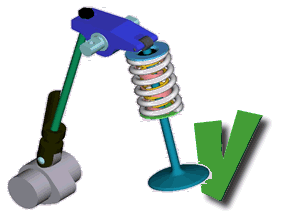|

Vacuum
Hoses and Motors Vacuum lines are a series of hoses, or tubing,
to the intake manifold. These hoses supply vacuum to various
components of the engine, such as the emissions control system. Most
air conditioning systems have vacuum motors to open and close the
doors on the air conditioning ducts. A vacuum motor is just a small
diaphragm with connecting rods to activate the valves of the system.
They have the advantages of simplicity and quietness.
Vacuum
Pump Most of the fuel pumps have a vacuum booster section that
operates the windshield wipers at an almost constant speed. The fuel
section then functions in the same way as ordinary fuel pumps. One
difference is that the rotation of the camshaft eccentric in the
vacuum pump also operates the vacuum booster section by actuating the
pump arm, which pushes a link and the bellows diaphragm assembly
upward, expelling air in the upper chamber through its exhaust valve
out into the intake manifold. On the return stroke of the pump arm,
the diaphragm spring moves the bellows diaphragm down, producing a
suction in the vacuum chamber. The suction opens the intake valve of
the vacuum section and draws air through the inlet pipe from the
windshield wipers. When the wipers are not operating, the intake
manifold suction (vacuum) holds the diaphragm up against the
diaphragm spring pressure so that the diaphragm does not function
with every stroke of the pump arm. When the vacuum is greater than
the suction produced by the pump, the airflows from the windshield
wiper through the inlet valve and vacuum chamber of the pump and out
the exhaust valve outlet to the manifold, leaving the vacuum section
inoperative. With high suction in the intake manifold, the operation
of the wiper will be the same as if the pump were not installed. When
the suction is low, as when the engine is accelerated or operating at
high speed, the suction of the pump is greater than that in the
manifold and the vacuum section operates the wipers at a constant speed.
Valve
A device through which the flow of liquid, gas, vacuum, or loose
material in bulk may be started, stopped, or regulated by a movable
part that opens, shuts, or partially obstructs one or more ports or
passageways. A valve is also the movable part of such a device.
The
valve opens and close the valve ports. If the ports were always
open, the fuel exploded in the combustion chamber would leave through
the ports. The explosion has to be kept in the combustion chamber to
push the piston down. The valves are set up to open and close at
exactly the right moment. One lets the fuel mixture in and closes.
After the fuel explodes and pushes the piston down, the other valve
lets the exhaust out.
Valve
Body Part
of the valve assembly containing plungers, pistons, springs, etc.
Valve
Clearance The clearance between the valve tip (the end
of the valve stem) and the rocker
arm or tappet.
The valve clearance is measured when the valve is closed.
Valve
Cover The valve cover covers the valve train. The valve train
consists of rocker arms, valve springs, push rods, lifters and cam (in
an overhead cam engine). The valve cover can be removed to
adjust the valves. Oil is pumped up through the pushrods and
dispersed underneath the valve cover, which keeps the rocker arms
lubricated. Holes are located in various places in the engine head so
that the oil recirculates back down to the oil pan. For this reason,
the valve cover must be oil-tight; it is often the source of oil
leaks. One way to determine if your valve cover is bent is to remove
the gasket and put the valve cover back on to the cylinder head. When
the valve cover and cylinder head come into contact, the cover should
sit flat. If it rocks, it is bent. A symptom of a bent or leaking
valve cover is a pinching of the valve cover gasket. This means that
the gasket is sealing one area and not sealing another area. This
condition produces a leak; oil could be leaking down the side of the
engine. Some valve covers are hard to access, because they are
covered with other engine parts. Chronic valve cover leakage can
sometimes be fixed by using two gaskets glued together instead of
using just one.
Valve
Lifter The valve lifter is the unit that makes contact with the
valve stem and the camshaft and rides on the camshaft. It opens the
valve when the cam lobes push it upwards. The engine oil comes into
the lifter body under pressure. It passes through a little opening at
the bottom of an inner piston to a cavity underneath the piston. The
oil forces the piston upward until it contacts the push rod. When the
cam raises the valve lifter, the pressure is placed on the inner
piston, which tries to push the oil back through the little opening.
It can't do this, because a small check valve seals the opening. When
the cam goes upward, the lifter solidifies and lifts the valve. Then,
when the cam goes down, the lifter is pushed down by the push rod. It
adjusts automatically to remove clearances.
Valve
Ports Valve ports are openings in the cylinder head. Intake
ports let the fuel mixture into the cylinder head, and exhaust ports
let the exhaust out.
Valve
Seals The valve seal is a unit that goes over the end of the
valve stem. It keeps excess oil from getting between the valve guide
and the valve stem.
Valve
Springs The valve springs keep the valves closed tightly against
their seats until the cam opens the valve. After the cam turns
(releasing pressure), the valve springs close the valves.
Valve
Train The collection of parts that make the valves operate,
allowing fuel intake, compression and exhaust. Includes the camshaft(s)
and all related drive components, and the various parts that convert
the camshaft's rotary motion into reciprocating motion at the valves.
See
The Internal Combustion Engine
Vane
A thin plate that is affixed to a rotatable unit to either throw off
air or liquid, or to receive the thrust imparted by moving air or
liquid striking the vane. In the first case it would be acting as a
pump and in the second case as a turbine.
Vernier
Caliper A precision measuring instrument that measures
inside and outside dimensions. Not quite as accurate as a micrometer,
but more convenient.
Viscosity
The thickness of a liquid or its resistance to flow.
Volt
A unit for expressing electrical "pressure" in a circuit.
One volt that will produce a current of one ampere through a
resistance of one ohm.
Voltage
Regulator The voltage regulator controls voltage and
current output of the alternator by automatically cutting resistance
in or out of the field circuit to keep it in a safe value. Varying
the resistance alters the amount of current passing through the
field. When the battery becomes fully charged, the resistance is cut
into the field circuit and the charging rate is decreased. In
electromagnetic regulators, the voltage regulator unit limits voltage
output by controlling the amount of current applied to the rotating
field. The field relay on these regulators connects the alternator
field windings and voltage regulator windings directly to the
battery. The conventional cutout relay unit has been eliminated by
the diodes in the alternator. The current regulator has also been
eliminated by the current-limiting characteristic of the alternator
design. Basically, in a transistorized or an electronic regulator,
the transistor is switched on and off to control the alternator field
current. The frequency of switching depends on the alternator speed
and accessory load, with the possibility that the on-off cycle may be
repeated as often as 7000 times per second. The transistorized units
have a voltage limiter adjustment. The electronic units are factory
calibrated and sealed. They are also nonadjustable.

A
B
C
D
E
F
G
H
I J
K
L
M
N
O
P
Q
R
S
T
U
V W
X
Y
Z |